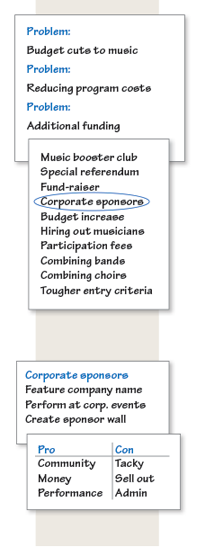87
Brainstorming Ideas
Once the group understands the problem it is facing, group members must generate ideas for solving the problem. The brainstorming process usually results in a lengthy list of ideas and possible solutions. Follow these tips.
Brainstorming Tips

- Identify the problem or issue. Clearly define the situation you are addressing, remembering that how you state the problem will limit or affect the solutions you’ll think of. In the box to the right, the problem of an underfunded music program is defined in three different ways. Each definition suggests a different type of solution.
- Ask group members to offer suggestions to solve the problem. At this point, the quantity of ideas is more important than the quality. You’ll have time to sort through suggestions later. By encouraging all ideas, you let group members know they will not be harshly judged for suggestions that are impractical, exorbitant, or counterproductive.
- Choose a recorder. This person writes down all suggestions in a list or cluster, perhaps on a white board or flip pad. The recorder does not pause to criticize suggestions but instead includes every suggestion that is offered in an honest attempt to solve the problem. Doing so keeps the ideas coming and avoids shutting off the flow.
- Select promising ideas. Next, the group selects a few promising possibilities to explore. Then the process begins again, brainstorming with each selected possibility.
- Pro-con evaluation. For each possibility, the group lists its pros (the good things about it) and its cons (the bad things about it).
- Choosing ideas to develop. After evaluating the pros and cons of each idea, the group selects an idea to move forward with.
Your Turn Select an issue or problem that you could address by collaborating with a group. With classmates, follow the steps above to brainstorm ideas.
